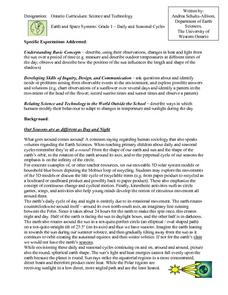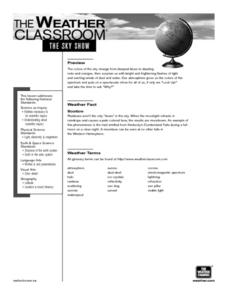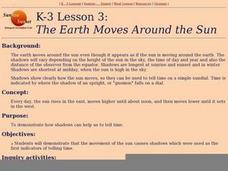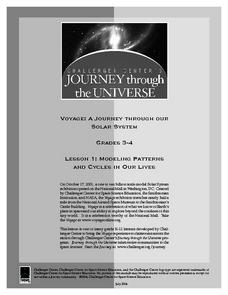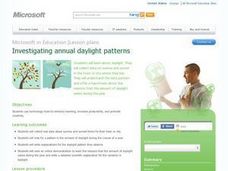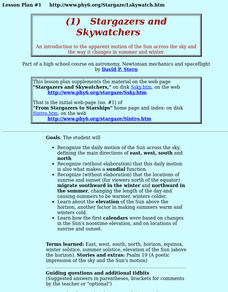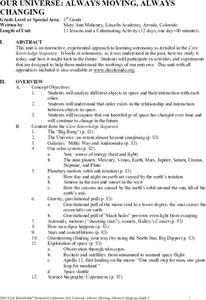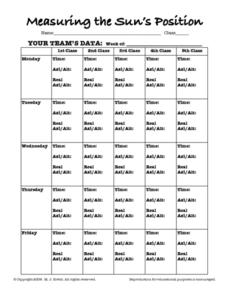Curated OER
Science: Daily and Seasonal Cycles
First graders use their observations to describe daily and seasonal cycles. through a demonstration using a suspended ball and flashlight, they determine the time of day in various locations. Next, 1st graders participate in a...
Curated OER
Sky Show
Students participate in a discussion of the sky and colors. They watch a demonstration of how colors can change. They examine the issue of if weather should be a part of their coursework.
Curated OER
Hello, Sunshine!
Students investigate how the sun travels across the sky at different latitudes using Solar Motion Demonstrator. In this earth science instructional activity, students explain why seasons change. They study how the tilt of the Earth's...
Curated OER
The Case of the Mysterious Red Light
Students investigate why some sunrises and sunsets are unusually bright red.
Curated OER
Why is the Sky Blue?
Students explore diffusion or scattering of light. In this physics instructional activity, students explain why the sky is blue and sunsets/sunrises are red.
Curated OER
Measure the Earth's Circumference
Students explore geometry by conducting a science experiment. In this circumference measurement lesson plan, students review the Greek geographer Eratosthenes who first discovered the circumference of our planet. Students utilize...
Curated OER
The Earth Moves Around the Sun
Students demonstrate that the movement of the sun causes shadows which were used as the first indicators of telling time.
Curated OER
Modeling Patterns and Cycles in Our Lives
Students explore how building a model can help them better understand the natural world. They identify common cycles or patterns in nature as well as examples of models in the classroom. After discussion, they choose a pattern or cycle...
Curated OER
Exploring Seasonal Shadows and Sunlight
What can shadows tell us about the changing season? Over several months, astronomy learners record length and position of an outdoor object's shadow, such as a flagpole. They apply the data to a growing hypothesis and note the...
Curated OER
Sundials and Shadows - What Can They Teach Us About Seasons?
Students collect and analyze data relating to seasonal changes. They view a video, research web sites and build a sundial to collect their data.
Curated OER
Investigating daylight
students investigate a natural factor affecting their everyday lives: daylight. First, they collect data on sunrise and sunset in their hometown, create a Microsoft Office Excel chart to help them understand the data pattern, and offer a...
Curated OER
Stargazers And Skywatchers
Students recognize the daily motion of the Sun across the sky, defining the main directions of east, west, south and north. They see how the first calendars were based on changes in the Sun's noontime elevation, and on locations of...
Curated OER
Stargazers and Skywatchers
Students observe the daily motions of the sun and relate them to the functions of a sundial. They determine the locations of sunrises and sunsets and determine how the elevation of the sun effects temperature.
Curated OER
Day and Night Definition Informational Page
In this day and night worksheet, students read an explanation of when daytime begins and end. They read that night-time is from sunset to sunrise. They read the definitions of AM and PM.
Curated OER
Astronomy: Picture Time
Students investigate how to tell time by observing the placement of objects in the sky. Researching on the Internet, they locate the time for sunrise and sunset, the time the full moon rises, and the difference between clock and solar...
Curated OER
Our Universe: Always Moving, Always Changing
Students explore the main concepts of astronomy through the eleven lessons of this unit. The past, present, and future methods of studying the science are examined in this unit.
Curated OER
Measuring the Sun's Position
For this sun worksheet, students measure the altitude of the sun and the azimuth of the sun to determine the sun's position five times a day for a week. They answer questions about their results.
Curated OER
Earth Rotation
Students examine the rotation of the Earth as it occurs in the 24 hour cycle. They use models of planets and the globe to make observations of movements made. Students brainstorm prior knowledge and then participate in a demonstration of...
Curated OER
Modeling the Change of Seasons
Students evaluate data to determine changes in length of day. They model the revolution of Earth around the sun to show changes in length of day and sun angle and illustrate how the sun angle affects the change of season.
Curated OER
Models of the Earth and Moon
Students explore the earth's rotation and phases of the moon. In this planets lesson, students rotate and revolve around a light representing the sun. Students use movement and props to simulate what causes the phases of the moon as well...
Curated OER
Reasons for Seasons
Students track photoperiod (daylight hours) over time and predict how daylight change during different seasons. This helps build their understanding that ever-changing daylight is the driving force for migrations and all other seasonal...
Curated OER
MLTI region
For this MLTI region worksheet, students answer multiple choice questions about the MLTI region and other NASA missions. Students answer four questions.
Curated OER
Astronomy
Students complete a unit of lessons on our solar system, its stars, and astronomers. They record information in a space journal, design constellations, define key vocabulary, observe the phases of the moon, and create a group planet...
Curated OER
Our Solar System
Students study the Earth and Solar System through a variety of activities. They compile a coloring book show the characteristics of the Sun and nine planets.
